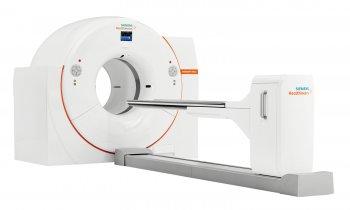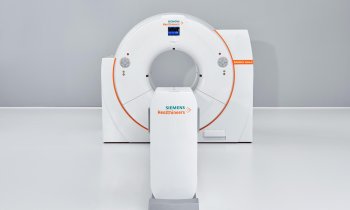Alzheimer disease: positive Phase II data with florbetaben
Bayer Schering Pharma AG, Germany, has presented positive data on a global Phase II study with the novel positron emission tomography (PET) tracer florbetaben (BAY94-9172) at the International Conference on Alzheimer's Disease (ICAD) in Vienna, Austria. This study showed that patients with a clinical diagnosis of Alzheimer´s disease could be differentiated from age-matched healthy volunteers (HVs) on the basis of florbetaben uptake pattern in the brain.
Until now, the clinical diagnosis of Alzheimer´s disease (AD) with current methods such as cognitive tests is still limited. Currently, a definite diagnosis of Alzheimer´s disease is only possible post mortem. The results of this study showed PET images with a high specificity of over 90 percent:
More than 90 percent of the HVs had a negative florbetaben scan (i.e. no tracer uptake) in the relevant brain regions. The results also show a sensitivity of approximately 80 percent indicated by the clinical diagnosis, meaning that about 80 percent of the clinically suspected Alzheimer patients had positive florbetaben scans indicating the presence of beta-Amyloid plaques. This is in line with the results of studies comparing the clinical diagnosis with the definite post mortem histopathological diagnosis.
"The data underline the potential of florbetaben as an important visual adjunct to existing clinical parameters in the diagnosis of dementia," said Kemal Malik, MD, member of the Board of Management and Head of Global Development at Bayer Schering Pharma AG. "There is a high medical need for an easy, non-invasive imaging technique that supports an early and precise diagnosis of dementia and especially of Alzheimer’s disease, allowing for optimized care and treatment options." With the development of florbetaben, Bayer Schering Pharma wants to contribute to diagnose AD in the future more precisely and at an earlier time during the course of the disease.
In the blinded read of the images a high interreader agreement rate between three independent readers was observed. This indicates that the scans with the beta-Amyloid targeted PET tracer florbetaben are easy to visually assess and that this assessment is highly reproducible.
Additional Phase II and pivotal Phase III global studies are under preparation to validate the potential shown by florbetaben in this Phase II setting. Start of the Phase III program is planned for end of 2009.
About the Phase II Study
This global Phase II, open-label, non randomized, multi-center study aims to evaluate the efficacy of florbetaben PET in vivo imaging in the detection/exclusion of cerebral beta-Amyloid plaques in patients with mild-to-moderate, probable AD (older than 55 years of age) compared with age-matched healthy volunteers. A total of 18 study centers in four countries (Australia, Germany, USA, and Switzerland) screened 213 individuals of whom 150 individuals were imaged with florbetaben receiving a single intravenous injection of the tracer. Reliable, high-quality images were obtained across multiple centers and camera types over a long time span. A 20-minute scan in this study provided optimal image quality.
The florbetaben uptake pattern was visually assessed for all time points by three independent, nuclear medicine physicians blinded to the clinical diagnosis and all other clinical data.
The co-primary efficacy variables were the sensitivity and specificity of the independent, blinded visual assessment of the images. As a secondary endpoint, the standard uptake value ratios (SUVRs) were also calculated using the cerebellar cortex as a reference region. The clinical diagnosis of AD served as the standard of truth, and was performed by the referring clinicians and based on internationally accepted and validated clinical criteria. The HVs were also carefully examined to include only those with a total lack of cognitive impairment. In addition, safety parameters were evaluated and various technical parameters assessed to define the optimal imaging procedure for further development (e.g. optimal imaging time points).
About Florbetaben (18 F)
Florbetaben is an inlicensed 18F-labeled PET tracer that specifically binds to beta-Amyloid plaques. These plaques consist of proteins that accumulate in the brain and are a pathological hallmark of Alzheimer’s disease. As the aggregation of the beta-Amyloid protein in the brain is also a key target for new therapeutic treatments under development, florbetaben might also be able to support the development of these new treatment approaches.
13.07.2009











